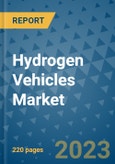1. Executive Summary
1.1. Global Hydrogen Vehicles Market Snapshot
1.2. Key Market Trends
1.3. Future Projections
1.4. Analyst Recommendations
2. Market Overview
2.1. Market Definitions and Segmentations
2.2. Market Dynamics
2.2.1. Drivers
2.2.1.1. Driver A
2.2.1.2. Driver B
2.2.1.3. Driver C
2.2.2. Restraints
2.2.2.1. Restraint 1
2.2.2.2. Restraint 2
2.2.3. Market Opportunities Matrix
2.3. Value Chain Analysis
2.4. Porter’s Five Forces Analysis
2.5. Covid-19 Impact Analysis
2.5.1. Pre-covid and Post-covid Scenario
2.5.2. Supply Impact
2.5.3. Demand Impact
2.6. Government Regulations
2.7. Technology Landscape
2.8. Hydrogen Fueling Stations - Market Overview and Statistics
2.9. Economic Analysis
2.10. PESTLE
3. Production Statistics, 2019 - 2022
3.1. Regional Production Statistics
3.1.1. North America
3.1.2. Europe
3.1.3. Asia Pacific
3.1.4. Latin America
3.1.5. Middle East & Africa
4. Price Trends Analysis and Future Projects, 2019 - 2030
4.1. Key Highlights
4.2. Prominent Factors Affecting Prices
5. Global Hydrogen Vehicles Market Outlook, 2019 - 2030
5.1. Global Hydrogen Vehicles Market Outlook, by Technology, Volume (Units) and Value (US$ Mn), 2019 - 2030
5.1.1. Key Highlights
5.1.1.1. Proton Exchange Membrane (PEM)
5.1.1.2. Phosphoric Acid Fuel Cell (PAFC)
5.2. Global Hydrogen Vehicles Market Outlook, by Vehicle, Volume (Units) and Value (US$ Mn), 2019 - 2030
5.2.1. Key Highlights
5.2.1.1. Passenger Vehicle
5.2.1.2. Commercial Vehicle
5.2.1.3. Heavy Commercial Vehicle
5.2.1.4. Coach & Buses
5.3. Global Hydrogen Vehicles Market Outlook, by Region, Volume (Units) and Value (US$ Mn), 2019 - 2030
5.3.1. Key Highlights
5.3.1.1. North America
5.3.1.2. Europe
5.3.1.3. Asia Pacific
5.3.1.4. Latin America
5.3.1.5. Middle East & Africa
6. North America Hydrogen Vehicles Market Outlook, 2019 - 2030
6.1. North America Hydrogen Vehicles Market Outlook, by Technology, Volume (Units) and Value (US$ Mn), 2019 - 2030
6.1.1. Key Highlights
6.1.1.1. Proton Exchange Membrane (PEM)
6.1.1.2. Phosphoric Acid Fuel Cell (PAFC)
6.2. North America Hydrogen Vehicles Market Outlook, by Vehicle, Volume (Units) and Value (US$ Mn), 2019 - 2030
6.2.1. Key Highlights
6.2.1.1. Passenger Vehicle
6.2.1.2. Commercial Vehicle
6.2.1.3. Heavy Commercial Vehicle
6.2.1.4. Coach & Buses
6.3. North America Hydrogen Vehicles Market Outlook, by Country, Volume (Units) and Value (US$ Mn), 2019 - 2030
6.3.1. Key Highlights
6.3.1.1. U.S.
6.3.1.2. Canada
7. Europe Hydrogen Vehicles Market Outlook, 2019 - 2030
7.1. Europe Hydrogen Vehicles Market Outlook, by Technology, Volume (Units) and Value (US$ Mn), 2019 - 2030
7.1.1. Key Highlights
7.1.1.1. Proton Exchange Membrane (PEM)
7.1.1.2. Phosphoric Acid Fuel Cell (PAFC)
7.2. Europe Hydrogen Vehicles Market Outlook, by Vehicle, Volume (Units) and Value (US$ Mn), 2019 - 2030
7.2.1. Key Highlights
7.2.1.1. Passenger Vehicle
7.2.1.2. Commercial Vehicle
7.2.1.3. Heavy Commercial Vehicle
7.2.1.4. Coach & Buses
7.3. Europe Hydrogen Vehicles Market Outlook, by Country, Volume (Units) and Value (US$ Mn), 2019 - 2030
7.3.1. Key Highlights
7.3.1.1. Germany
7.3.1.2. France
7.3.1.3. U.K.
7.3.1.4. Switzerland
7.3.1.5. Netherland
7.3.1.6. Rest of Europe
8. Asia Pacific Hydrogen Vehicles Market Outlook, 2019 - 2030
8.1. Asia Pacific Hydrogen Vehicles Market Outlook, by Technology, Volume (Units) and Value (US$ Mn), 2019 - 2030
8.1.1. Key Highlights
8.1.1.1. Proton Exchange Membrane (PEM)
8.1.1.2. Phosphoric Acid Fuel Cell (PAFC)
8.2. Asia Pacific Hydrogen Vehicles Market Outlook, by Vehicle, Volume (Units) and Value (US$ Mn), 2019 - 2030
8.2.1. Key Highlights
8.2.1.1. Passenger Vehicle
8.2.1.2. Commercial Vehicle
8.2.1.3. Heavy Commercial Vehicle
8.2.1.4. Coach & Buses
8.3. Asia Pacific Hydrogen Vehicles Market Outlook, by Country, Volume (Units) and Value (US$ Mn), 2019 - 2030
8.3.1. Key Highlights
8.3.1.1. China
8.3.1.2. Japan
8.3.1.3. South Korea
8.3.1.4. India
8.3.1.5. Australia
8.3.1.6. Rest of Asia Pacific
9. Latin America Hydrogen Vehicles Market Outlook, 2019 - 2030
9.1. Latin America Hydrogen Vehicles Market Outlook, by Technology, Volume (Units) and Value (US$ Mn), 2019 - 2030
9.1.1. Key Highlights
9.1.1.1. Proton Exchange Membrane (PEM)
9.1.1.2. Phosphoric Acid Fuel Cell (PAFC)
9.2. Latin America Hydrogen Vehicles Market Outlook, by Vehicle, Volume (Units) and Value (US$ Mn), 2019 - 2030
9.2.1. Key Highlights
9.2.1.1. Passenger Vehicle
9.2.1.2. Commercial Vehicle
9.2.1.3. Heavy Commercial Vehicle
9.2.1.4. Coach & Buses
9.3. Latin America Hydrogen Vehicles Market Outlook, by Country, Volume (Units) and Value (US$ Mn), 2019 - 2030
9.3.1. Key Highlights
9.3.1.1. Brazil
9.3.1.2. Costa Rica
9.3.1.3. Rest of Latin America
10. Middle East & Africa Hydrogen Vehicles Market Outlook, 2019 - 2030
10.1. Middle East & Africa Hydrogen Vehicles Market Outlook, by Technology, Volume (Units) and Value (US$ Mn), 2019 - 2030
10.1.1. Key Highlights
10.1.1.1. Proton Exchange Membrane (PEM)
10.1.1.2. Phosphoric Acid Fuel Cell (PAFC)
10.2. Middle East & Africa Hydrogen Vehicles Market Outlook, by Vehicle, Volume (Units) and Value (US$ Mn), 2019 - 2030
10.2.1. Key Highlights
10.2.1.1. Passenger Vehicle
10.2.1.2. Commercial Vehicle
10.2.1.3. Heavy Commercial Vehicle
10.2.1.4. Coach & Buses
10.3. Middle East & Africa Hydrogen Vehicles Market Outlook, by Country, Volume (Units) and Value (US$ Mn), 2019 - 2030
10.3.1. Key Highlights
10.3.1.1. GCC
10.3.1.2. Rest of Middle East & Africa
11. Competitive Landscape
11.1. Company Market Share Analysis, 2022
11.2. Competitive Dashboard
11.3. Strategic Collaborations & Synergies
11.4. Company Profiles
11.4.1. Foshan Feichi Automobile Manufacturing Co, Ltd.
11.4.1.1. Company Overview
11.4.1.2. Product Portfolio
11.4.1.3. Financial Overview
11.4.1.4. Business Strategies and Development
11.4.2. SAIC Motor Corp. Ltd.
11.4.3. Ford
11.4.4. Stellantis N.V.
11.4.5. Sunlong Bus
11.4.6. BMW AG
11.4.7. GM Corp.
11.4.8. Daimler AG
11.4.9. Audi AG
11.4.10. Toyota Motor Corporation
11.4.11. Hyundai Motor Company
11.4.12. FuelCell Energy Inc.
11.4.13. Honda Motor Company Ltd.
11.4.14. Tata Motors
12. Appendix
12.1. Research Methodology
12.2. Report Assumptions
12.3. Acronyms and Abbreviations








